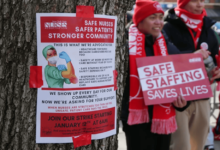NHS data shows 6% increase in nurses and midwives

The overall number of nurses and midwives in the NHS has risen by around 6%, official figures have shown – but health visitors and learning disability nurses are on the decline.
New statistics released by NHS England today (25 January) showed that the number of full-time equivalent (FTE) registered nurses and midwives working in the NHS and general practice increased by 21,817 between November 2022 and November 2023.
“We still have some way to go which is why it is vital we continue to build our workforce”
Ruth May
This 6.2% rise put the number of FTE nurses and midwives at 372,411, as of the start of winter, from 350,594 at the same time in 2022. NHS England recorded a registered nursing and midwifery staff headcount of 414,918.
This number has been rising year on year since 2017, with the increase between 2022 and 2023 being the largest in that period.
All specialities of nursing rose in the 2022-23 period except learning disability nursing and health visiting, which dropped by 0.1% (a total of four) and 1.5% (87) respectively.
The number of nurse consultants increased by 61 to 759 (8.7%) in adult nursing, and also rose in the children’s nursing specialty. However, consultant nurse numbers fell in community, mental health and school nursing specialties.
The number of FTE registered midwives, meanwhile, rose by 5.2% to a total of 23,396 as of November 2023.
NHS England said this meant the registered nursing and midwifery workforce was the largest it had been since figures began to be recorded in September 2009.
It attributed “unprecedented growth” of the workforce to retention programmes, international recruitment, new routes into the professions and domestic recruitment drives.

Ruth May
Dame Ruth May, chief nursing officer for England, said she was pleased with the growth but acknowledged there was still a way to go to achieving the ambitions of the NHS Long Term Workforce Plan.
This plan, published in June 2023, committed the NHS to increasing the number of nursing training places by 80% by 2031-32.
“Nurses, midwives, nursing associates and support workers are a crucial part of our NHS workforce, providing essential treatment and care to patients and communities,” said Dame Ruth.
“Of course, we still have some way to go which is why it is vital we continue to build our workforce as set out in the NHS Long Term Workforce Plan – through increasing the number of future nurses and midwives in training and improving retention.
“Key to this is improving the experiences of our colleagues who work so hard to provide patients and the public with the very best care.”
England’s chief midwifery officer Kate Brintworth aired similar cautious optimism at the figures: “With 1,000 more midwives in our workforce than a year ago, the results of this data show green shoots of progress and are a welcome boost for our maternity and neonatal services.”

Kate Brintworth
Health minister Andrew Stephenson added that the rise of nurses and midwives was “fantastic”, and said the government was committed to supporting the ambitions of the workforce plan.
The Royal College of Nursing (RCN)’s director for England, Patricia Marquis, was less optimistic.
Ms Marquis said there was still a “long way to go” before the ongoing nursing and midwifery workforce crisis was solved, adding that there were still around 40,000 nursing posts to be filled in the English NHS.
“Empty nursing posts result in unsafe patient care and right now, one nurse is often responsible for 10, 15 or more patients at one time,” she said.
“In the last three years, the NHS waiting list has exploded – it’s grown four times faster than the nursing workforce.”
The RCN England director also criticised one of the key methods by which the health service has increased its numbers: “The government is reliant on unsustainable, unethical recruitment practices. Half of all new nursing staff are internationally recruited, and many have come from ‘red list’ countries who cannot spare their nursing staff.
“At the same time, the number of nursing students is falling, not rising – down 10.5% percent this year.
“If the government is serious about providing safe patient care, it should make nursing an attractive profession for people to join. This includes a fair pay deal for this year and scrapping tuition fees for nursing students.”
The number of FTE doctors working in the NHS and general practice also increased by 5.2%, to a total of 148,875.
Non-professionally regulated support and infrastructure staff also rose, the figures showed.
Professor Mark Radford, director of Education and training for NHS England, added: “We are so pleased to see the growth within the nursing, midwifery and support staff workforce and will build on this as we work to achieve the long-term workforce plan commitment to train and retain more nurses and midwives.
“Showing people what a nursing or midwifery career has to offer will be vital to the success of the NHS Long Term Workforce Plan and the NHS is growing a number of entry routes, such as the nurse degree apprenticeship, to make sure a career in nursing is a possibility for as many people as possible.”







